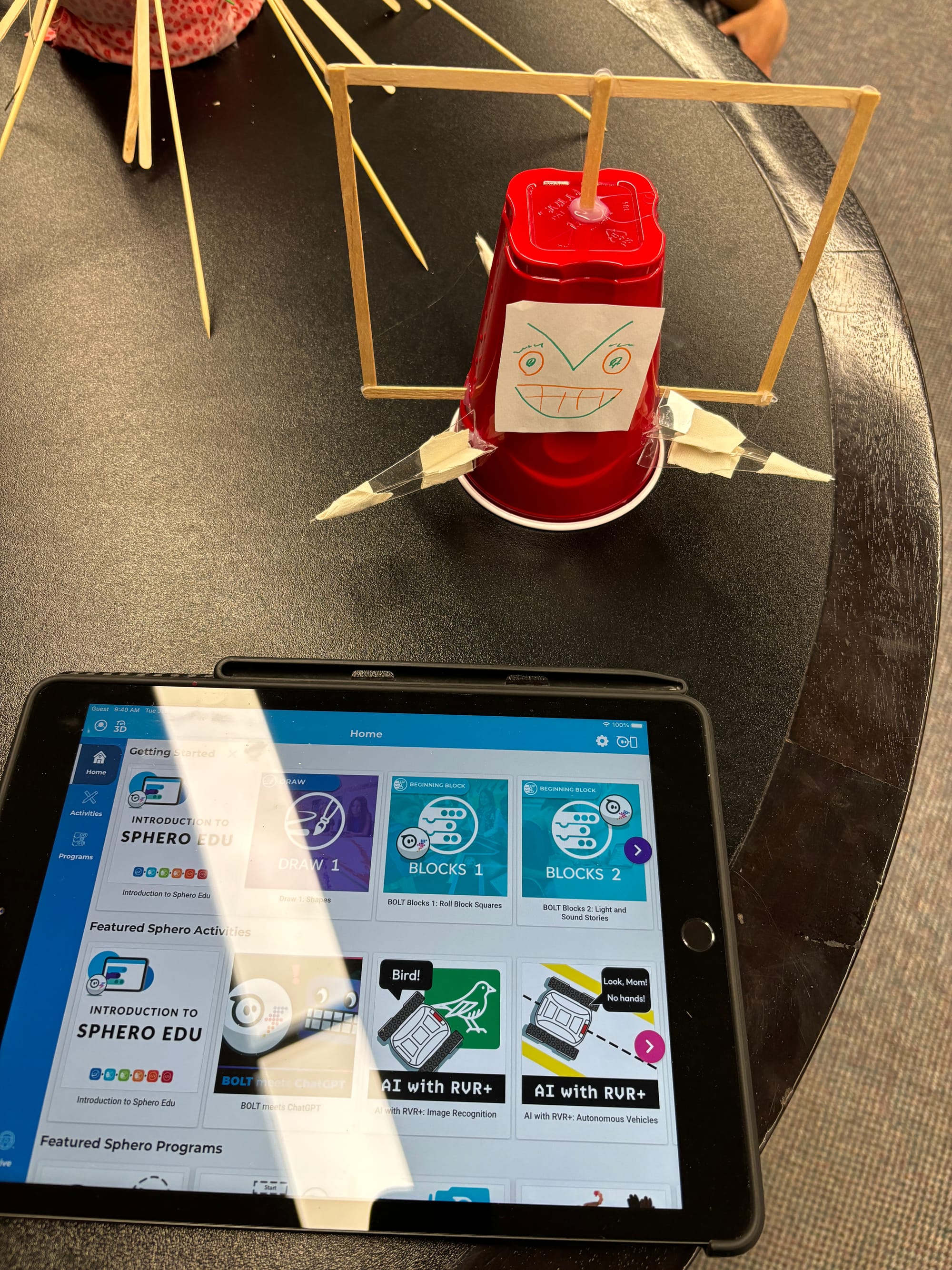Remember those epic robot battles from the Discovery Channel? We were inspired by the chaos to create an engaging, cross-curricular design challenge. Here's a couple stories about how teachers have embraced the bots and some ideas that we think could bring this lesson to the next level.
Battlebot Design Sprint 🚧
In Regi's Grade 6 class, the energy was electric as students dove into their first battle challenge. Armed with basic materials (cardboard, tape, recycled plastic, stir sticks, wooden skewers, and red solo cups) and boundless creativity, they crafted unique battlebot armors in just 20 minutes. Despite working with identical supplies, each creation had its own personality. Students were tasked with creating armour for a Sphero robot starting with the red solo cup.



The battlefield? Two hula hoops, with students gathered in an eager circle around the arena. Using four Spheros, teams went head-to-head in tournament-style matches. Victory was achieved in two ways: pushing opponents out of the ring sumo-style, or knocking off their robot's armor.
The real learning happened in those intense moments of competition. Students quickly discovered that heavier armor meant less maneuverability, while top-heavy designs were prone to tipping. These organic physics lessons had everyone buzzing with ideas for improvements.
Testing experimental lightweight armour.
Balloon Bursting Bots 🎈
In Dwayne’s Grade 6 class, the students decked out Wonder Dash robots with cardboard, skewers and balloons. What started as a series of 1-on-1 battles, turned into an all-out battle royale with a swarm of robots fighting for victory. The last bot with an inflated balloon won!
Mario Kart inspired Balloon Popping Battle Bots!
As an added challenge, students experimented with creating movement loops with code, attempting to get their bots to fight autonomously! While this proved harder than expected, they did learn how different movement strategies might align better with different armour and balloon-popping configurations.
Through these battles, watching students tackle the battlebot challenge revealed natural design principles at work.
- Should they prioritize offensive capabilities or defensive strength?
- Which materials offer the best combination of durability and maneuverability?
- How should they move around the arena to best their opponent?
Every match became a laboratory for practical physics and experiencing engineering concepts.
The Economics of Building Battlebots 💰
If you’ve ever watched Battlebots, you’ll notice that the teams who spend their resources wisely, generally perform better than those who add superfluous details to their combat bot. So we proposed introducing a real-world budget to the building process.
- Students begin by bringing materials from home to contribute to a shared marketplace.
- The pricing discussion becomes a lesson in itself – students debate the relative value of materials, wondering if premium items like duct tape should cost more than basic masking tape. From there, a pricing list for parts is developed.
- Each team receives a budget to work with, turning material selection into strategic decision-making.
- Students could weigh costs against benefits, and might discover that the most expensive materials aren't always the best choice.
- Finally, we suggest implementing a "buy-back" program where teams could return unused materials for partial refunds, teaching lessons about resource management and financial planning.

Let us know if you want to try this idea in your class!
Where Design Meets Curriculum 🧰
The beauty of battlebot competitions lies in how naturally they align with ADST curriculum goals: Applied Design, Applied Technologies, Robotics, Computational Thinking. Not to mention the add-on of Financial Literacy in Math.
Students don't just build robots – they engage in authentic design thinking, create and test prototypes, and implement improvements based on battle results. The immediate feedback from competitions drives natural iteration cycles, helping students understand the value of continuous improvement.

Start Your Own Battlebot Design Project
The path to your first battlebot tournament starts with building excitement. Encourage students to scout potential building materials at home, then work together to create your classroom marketplace. As teams form and building begins, you'll see collaboration and creativity flourish. Remember to allow plenty of time for testing and modification – some of the best learning happens when students can iterate on their designs between battles.
Battlebots Youngest Captain 🐣
Who knows? You might have the next Tyler Nguyen in your class!


